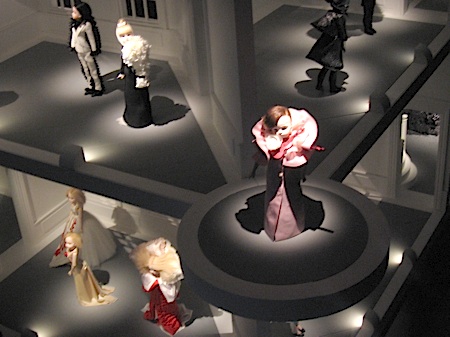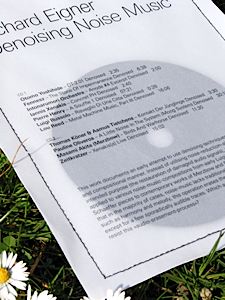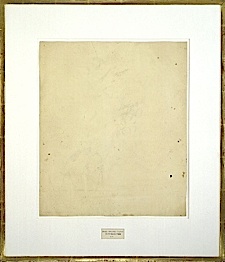The Voise of Noise
[ Viktor & Rolf | Matthew Herbert | Richard Eigner ]
january 06, 2009.
Little will make me as happy as happening upon a good idea, be
it my own, or somebody else's. Even more so when that idea is a dead simple
one; one that anyone could have come up with. And, well indeed:
in some of these cases maybe many did think of it before. But originality
here is not our concern. 
What counts is that first moment of confrontation, of recognition.
Like in the afternoon of friday January 2nd, when for the first time I saw
high heels added onto the traditional dutch klompen
(wooden shoes). Onto clogs decorated as Delftware,
like the one in the picture; but also onto the plain yellow ones, for your
everyday use. The clogs are from the collection of the dutch designers Viktor
Horsting and Rolf Snoeren, better known by their brand name Viktor
& Rolf, and are currently on show in 'The House of Viktor &
Rolf', an exhibition that, after the Barbican
in London last year, came to the Centraal
Museum in Utrecht (the Netherlands). It gives a retrospect of the duo's
work over the past fifteen years.
 'The
House of Viktor & Rolf' is a very nice exhibition. It is crammed
with ideas. Not all of them are as simple as the wooden clogs with heels,
of course, but several do come close. Apart from the clogs I
guess I should mention the wearable light- and sound system, which turns
each of Viktor & Rolf's mannequins
into his or her very own, autonomous fashion show. Now I think that this would be even
better as an add-on for the performing musician, who could thus become his/her
very own, autonomous stage ... Using a wireless connection to a concert
hall's (or whatever other) sound system, and using the built-in amplifier and speakers for
monitoring, the performer will be free to move and go wherever (s)he sees fit,
while continuing to be in the spot-light ...
'The
House of Viktor & Rolf' is a very nice exhibition. It is crammed
with ideas. Not all of them are as simple as the wooden clogs with heels,
of course, but several do come close. Apart from the clogs I
guess I should mention the wearable light- and sound system, which turns
each of Viktor & Rolf's mannequins
into his or her very own, autonomous fashion show. Now I think that this would be even
better as an add-on for the performing musician, who could thus become his/her
very own, autonomous stage ... Using a wireless connection to a concert
hall's (or whatever other) sound system, and using the built-in amplifier and speakers for
monitoring, the performer will be free to move and go wherever (s)he sees fit,
while continuing to be in the spot-light ...
Though I'm pretty much sure
that someone must have constructed something like this before, in the Centraal
Museum this did strike fPcM and myself as an absolute 'ookoi
must have' ...
Why didn't we think of this before ...? :-)
 |
[ You can visit 'The House of Viktor & Rolf' in the Centraal Museum in Utrecht (Nicolaaskerkhof 10) between 11h and 17h, from tuesday till sunday, until february 8th, 2009. ]
[ Matthew Herbert | Viktor & Rolf | Richard Eigner ]
I first heard some of Matthew
Herbert's music (or that of one his several monikers') a couple
of months ago, when I came across his 2005 album Plat
du Jour.
Herbert's a fascinating case. He also seems to be very successful. In the
world of electro/techno/dance music, that is, which is pretty alien to me.
I am somewhat familiar with Matmos,
though. That is because of their album A
Chance to Cut Is a Chance to Cure
(2001), which to great effect uses field recordings made during liposuction
surgery, refractive eye surgery, rhinoplasty, endoscopic forehead lift,
chin implant, the response curve testing of hearing aids, a plucked and
bowed rat cage, and sounds made with human skull, goat spine and artificial
teeth. Just to list some of the exotic sound sources that went into Matmos'
sampling machines to color the tracks on that album. Out come atmospheric
pieces like For Felix (And All the Rats), and several laid back
beat-based tracks; most of these probably would be less than remarkable
were it not for the highly unusual and not readily accessible sonic environments
going into the sonic palette that were used to paint them.
But do the exotic timbres and the corresponding real-world references manage to add another, deeper layer of meaning to the music as such?
I do not know.
I cannot make up my mind. Notwithstanding - or is it because of ? - the deliciously ambiguous message of a 'cosmetic music' made almost entirely out of sounds taken from cosmetic
surgery ...
Matthew Herbert's work
is Matmos-related, but takes several large steps beyond. I had put his Plat
du Jour
album, together with a large selection of other pop- and rock-music files
(from artists with names covering a scale all the way on from Abba
to ZZ-Top), onto the iPod of my 11 year old daughter. This I tell
you, because after listening she told me that she had especially liked Plat du Jour.
In doing so, she referred to it as the record with music made 'with sounds
from the kitchen', even though I had not told her anything of the kind.
I found it remarkable that the album's 'concept' appeared to be so evident to a child's ear.
All sounds used on Plat
du Jour
are one way or another related to food and the food chain. According to
the website dedicated to
the record, which lists in great detail the ingredients of each one
of its tracks, there is even more to it than just 'sounds from the kitchen'.
The making of the record included 'ritual' extravaganza like the recreation of "the
meal Nigella
Lawson cooked for George Bush when he came to Britain to thank Tony
Blair for his support during the Iraq war", subsequently driving
over it "with a Chieftain
MK 10 battle tank from the mid-late 1960s" (in "Nigella, George, Tony
and me") and the making of field recordings from "the sewers beneath Fleet Street, London,
accessed by a manhole cover near the Unilever building at Blackfriar's Bridge
at midnight" (in "Wasteland").
Though most of the album's liner notes reads as an hilarious parody on some or other phonographic purist's 'hitlist', there is no reason to doubt the verisimilitude of these ingredients. Herbert had the means and the support, and he took all the time it takes to research and create. Most important of all: over the years Matthew Herbert seems to have built up the necessary sociopolitical anger and motivation. So then why not put an advisor to the foreign office together with his girlfriend in a kitchen to bake an apple pie, following the indications of one of Nigella Lawson's recipes? And then why not bring the pie to the site of one of the opening battles of the American civil war (in Manassas), in order to record the sound of it being shot at that precise spot by a US ex-military intelligence officer with a 9mm Luger, as formerly used by a Nazi SD officer?
I don't think that's weird. I mean, I think I do understand the logic that makes doing this a necessity.
Taking the referents of the field recordings and sounds he uses very literally
is part of this logic. It is the kind of logic that goes with magic. In
which 'sound' is thought of as being of a 'material' nature. Herbert's sounds
are, in a very literal sense, concrete sounds. It is essential
to his work. He uses these sounds because of where they came from
or because of how they came about, and because of where
they stand for. Because a sound is not merely a symbol of, but
is 'pervaded' by (or maybe even is) the 'spirit' or 'soul' of its
source. As he states in a recent interview, Herbert is convinced that thanks
to current recording technology and electronic samplers, music no longer
has "to pretend to be about something. It doesn't have to evoke
something, it can actually be that thing. Instead of having to
write lyrics about the Houses of Parliament I can actually go in there and
record the sounds and actually use these themselves ..." (
* ) Thus Plat
du Jour
stands as curious (but honest, I think) attempt to denounce the contradictions,
pitfalls and evils of the capitalist & corporate control over all that
we eat, by means of lively, melodic and danceable pop, through highly varied,
smart and entertaining music, that is built from - exclusively - sounds recorded
all along our food chain. Hence by 'magical' extension: it is pop music
made out of food.
But isn't it a strange twist of thought, to think that music that would want to be about, for example, love, would merely be pretending, unless it were built from the recorded sounds of real life love making? Or that a song protesting war can only be real when it is set to a beat made from the sounds of flak ... ?
Under the name of Radio Boy in 2001 Herbert made a record that is conceptually similar. "The Mechanics of Destruction" was a free (or at least non-profit) CD, with tracks like MacDonalds (with a Big Mac meal as its sole sound source), Television (sounds made with Herbert's granddad's old black and white TV), Gap (using blue Gap boxer shorts for the sounds), Coca Cola (one can of Coke, one can of Pepsi), und so weiter ...
The fascinating paradox of course is that a beat remains a beat, whether its timbre is that of the sound made with a Big Mac meal, of sounds made with a copy of the Sun newspaper, or the clanking sound produced handling Coke cans ... What message will prevail? That of the beat, or that of (the source of) its sound? ... Of course it is naive to imagine that 'the voise of a noise' will remain attached even to a dance track, as some sort of a gas, as a semantic smell, that may be picked up by those that are exposed to it, however much such 'noise' has been molded to fit the temporal and dynamic envelope of more traditionally colored notes. Or is it? Should not a sound be let free for it to be able to speak? ... Is the 'message' included - encoded! - in Herbert's tracks then mere auto-justification? An excuse on the maker's side for doing the things he does?
I have been listening quite a bit to Herbert's records recently, and as before with Matmos: I cannot make up my mind. Contrary to the sounds it is made of, Herbert's music by itself rarely is truly extravagant, exotic or 'revolutionary'. He's a gifted musician, though, writing intelligent and seductive tunes, which I find a pleasure to listen to ... So let me remain open to the idea, to the mere possibility of spreading and making heard a critical sociopolitical message by means of a jazzy kinda of well-formed pop music, solely by pointing to what the sources of the sounds that were used in putting it together mean and signify ...
I therefore am much looking forward to receiving my copy of
There's Me And There's You,
the most recent album by the Matthew Herbert Big Band, which allegedly, among others, is making use of the sounds of
"70 condoms being scraped across the floor of the
British Museum, 100 nails being hammered into a coffin, 100 credit cards being cut up, a sound collage of 100 people saying ‘yes',
and field recordings from Palestine" ...
The new CD's cover consists in a
petition signed by all of the Big Band's musicians. This is what it says:
"We, the undersigned, believe that music can still be a political force
of note and not just a soundtrack to over-consumption". It made me
think back to the afternoon that I spent several decades ago in a London
ice cream parlor, discussing the politics of pop with Scritti
Politti's Green Gartside, who some days later sent me a pack
with hundreds of pages of photocopies with handwritten notes and schematics
on pop, politics, deconstruction and Derrida,
that I only started to look at in detail many years later, when I heard
of the by then practicing politician of pop's over-desperate soul-struggling
to get invited also to the hippest of New York parties.
I never found the error, though. Maybe Matthew Herbert would know ...?
...
Now I got this far, I almost forgot the reason why I began writing about Matthew
Herbert's music in the first place. That is because of the many great ideas
that abound, not so much in the music, as in the recording of its sounds.
Especially one of these, used in the process of making Plat
du Jour,
I found simply wonderful: when Herbert did, for example, a public DJ
set, he would bring along a box of apples. These he would distribute in
the audience, and then ask the people present (at the count of 3
or 4, I presume) to all simultaneously bite their apple. He recorded
these 'public multi-crunches'. The resulting sound (of 3.555 people biting
an apple) is amazing, composed as it is of a great many individual and all
not quite the same bites. It is (of course) wave-like, as it is
made by what we should consider 'an alien ocean'. It is this sound
that constitutes the main texture of An apple a day (which, btw,
- like Pigs in Shit - is one of tracks on the album that remain
'abstract': without a beat, without a melody).
[ Read about the politcs and the passion along with some of the how's and the why's of Matthew Herbert's approach in his own words, in The Deafening Silence in Political Music, a blog piece that he wrote for the Guardian (nov. 2008). ]
[ Richard Eigner | Viktor & Rolf | Matthew Herbert ]
Richard Eigner was one of the young Austrian artists/students that were part of Wolfgang Dorninger's 8-piece Phonographic Arkestra, opening das kleine's Big evening at the Berlin Tuned City festival, early july 2008. Some time before the concert, Wolfgang explained to me the set-up of the Arkestra, and outlined the procedures that the Arkestra would follow during their performance. He told me that among the DSP-tools that he would use to treat his set of field recordings, there would be a denoiser. In passing he mentioned an interesting work of Richard Eigner, in which the use of denoising applications plays a central role.
The possibility to remove unwanted & disturbing sounds, as well as background noise (clicks, hiss, cuts) from audio (or video) recordings - otherwise said: clean them up - and/or to isolate and 'boost' a specific ('intended') part of a recording, have dramatically increased with the advent of digital techniques; the still increasing speed of processors makes it possible to apply ever more subtle, 'intelligent' and powerful algorithms to a recording, in order to get at the part that one wants. Be it in order to extract and make audible speech that appears as 'unintelligible' in the original recording, the removal of 'noises' from early and historical or damaged recordings, or simply take out the clicks and the hiss when transferring old vinyl albums to your PC.
But of course one may use these algorithms also in a different
way. You may put them to work for other than analytical and/or restoring
purposes, as a compositional tool, in a creative manner.  This is what Richard did. He had a simple
but beautiful idea, which of course is what got him a place in
this SB-entry's small gallery of great ideas: he denoised noise music ...
This is what Richard did. He had a simple
but beautiful idea, which of course is what got him a place in
this SB-entry's small gallery of great ideas: he denoised noise music ...
"Denoising Noise Musik" in fact is his thesis (
** ). The paper (in German) starts out with a short and concise history
of noise (in) music. It then gives an overview of the different 'noises'
that may occur in audio recordings, and proceeds with the history and principles
of noise-reduction and de-noising, from analog to digital.
The fun and interesting part however is in the fourth chapter: "Denoising
Noise Music - ein dekompositorischer Produktionsprozess". Here Richard
puts his 'denoising' action in the artistic tradition of 'decomposition',
starting with Dada (Tristan Tzara) and Duchamp, and leading via the Cagean
opening up of musical practice of music to 'any sound you can imagine' to
the contemporary and - in a way - 'paradoxical' genre of noise music.
An algorithm written in order to 'eliminate noise', when confronted with a work of 'noise music' will just do that: remove the noise ... in case the work treated lacks traditional musical/structural elements like 'melody' or 'rhythm', it many cases that means that the algorithm actually will attempt to 'erase' the work ...
 Thus
the 'denoising' comes close to George Maciunas action 'Homage
to Richard Maxfield' (from 1962), in which after the playing back of
a tape composition of the composer, the tape is to be erased while rewinding
it. Richard Eigner also links his 'denoising of noise-music' to
Robert Rauschenberg's 'Erased De Kooning drawing' (1953), where one of the
several layers of interest resides in the fact that Rauschenberg's meticulous attempts
at making De Kooning's drawing disappear even in the very end continues to leave traces. Similarly,
the interest of listening to Eigner's examples of denoised pieces noise music obviously
resides in what it is that remains ...
Thus
the 'denoising' comes close to George Maciunas action 'Homage
to Richard Maxfield' (from 1962), in which after the playing back of
a tape composition of the composer, the tape is to be erased while rewinding
it. Richard Eigner also links his 'denoising of noise-music' to
Robert Rauschenberg's 'Erased De Kooning drawing' (1953), where one of the
several layers of interest resides in the fact that Rauschenberg's meticulous attempts
at making De Kooning's drawing disappear even in the very end continues to leave traces. Similarly,
the interest of listening to Eigner's examples of denoised pieces noise music obviously
resides in what it is that remains ...
Richard Eigner applies denoising to works as divers as Merzbow's
Bird and Warhorse, Pierre
Henry's Souffle I, Iannis
Xenakis' Concret PH (which is my favorite Xenakis tape piece),
A little noise in the system by Pauline
Oliveros, two pieces by Fennesz,
the third part of Lou
Reed's Metal Machine Music, and a couple more.
Now a whole lot more could be said, but I will leave you with the observation that he result of denoising of course dramatically will vary with your 'tuning' of the application or plug-in ... Arguably the biggest surprise in Richard's experiments is the undulating and spacious field of interlaced crispy clear (sine wave / overtone) melodies arising from the dense wall of heavily distorted (guitar) feedback in Reed's Metal Machine Music ...
Many viewers will have DSP-software including one or more denoising plug-ins.
I suggest you just try it for yourself ... :-)
[ Read some more about erasure in art : Sous Rature - Stoffel Debuysere (Diagonal Thoughts, dec. 2008) | Erasure in Art - Richard Galpin, feb. 1998 ]
notes __ ::
(*) Matthew
Herbert Big Band interview, by Bob Baker Fish, in: Cyclic Defrost Magazine, issue 21, december 2008. The
emphases in the quote are mine.
[ ^ ]
(**) " Diplomarbeit zur Erlangung des akademischen Grades 'Magister (FH)'. Vorgelegt am FH-Studiengang MultiMediaArt,
Fachhochschule Salzburg, Begutachtet durch
Fritz Ostermayer,
Dipl.Ing. (FH) Martin Löcker. Linz, 26.5.2006. "
[ ^ ]
tags: Viktor & Rolf, Utrecht, Matthew Herbert, Matmos, noise, denoise, Richard Eigner
# .289.
smub.it | del.icio.us | Digg it! | reddit | StumbleUpon
comments for The Voise of Noise ::
|
Comments are disabled |